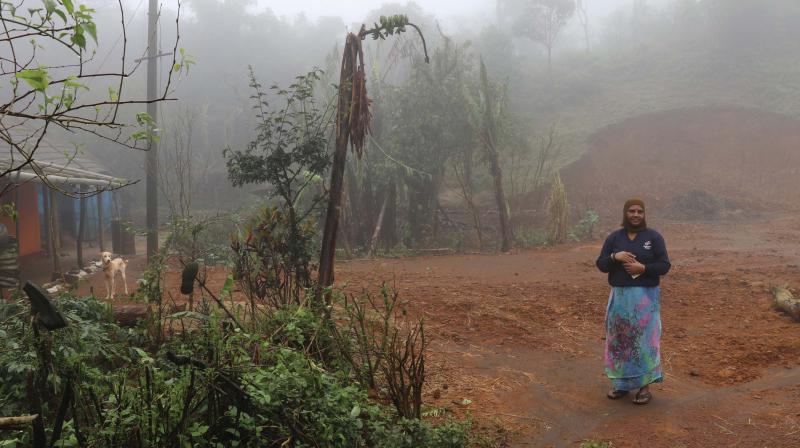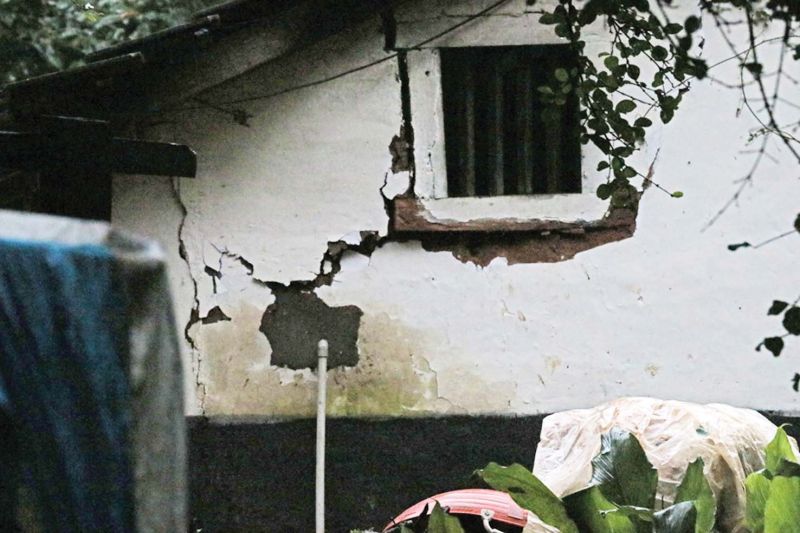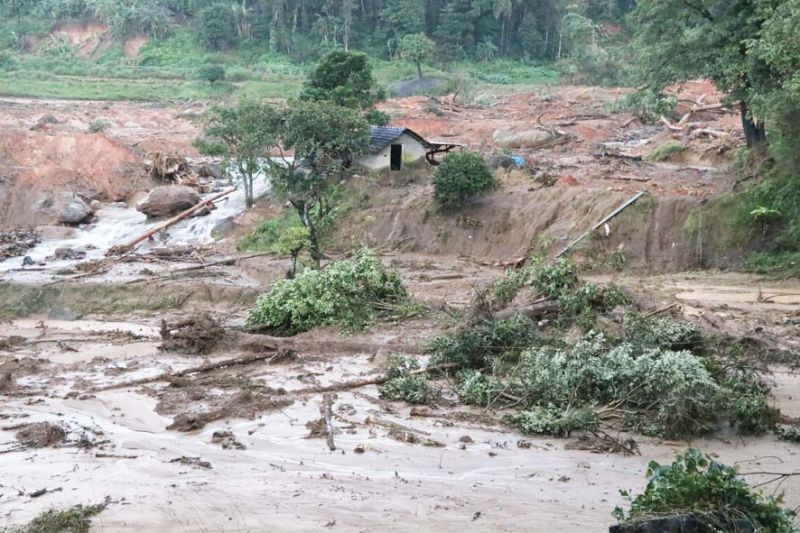Wake up Kodagu But where's the coffee?

Two weeks ago, picturesque Kodagu was the perfect destination for a tourist with the homestays and resorts, dotting the lush green coffee estates; the verdant hills, offering the perfect getaway for anyone looking for a respite from the pressures of urban life. Not anymore. Today, the land of the Kodavas has been wrecked beyond imagination, with the plantations washed away, the homestays collapsing as the earth caved in, landslides and incessant rain bringing a martial race, who have never bowed before adversity, to the crossroads. Can Kodagu recover from this massive blow from the skies and the hills, which has left its people in penury and dealt a mortal blow to the local economy? VINAY MADHAV travels through some of the worst-affected places in this unique land abutting Kerala, and unravels heartrending tales of woe and destruction, of people trying to find their feet after their carefully nurtured dreams came crashing down in a sea of mud and debris.
Before the deluge and landslides took it all away, Siddanda Harish used to work in a club at Madikeri and travelled from Kalooru to the district headquarters – a distance of around 15 km. Just before the landslide which ravaged his property, Harish had sent his family members to his in-laws home and that probably saved them. “In Kalooru, all my property has been wrecked and the house is partially damaged. There is destruction all around, at Makkandur and even at Mandalpatti. Getting over this is not going to be easy,’’ he says grimacing.
 A house at Iggudlu village near Madapura develops cracks after a massive landslide just 50 metres away from it
A house at Iggudlu village near Madapura develops cracks after a massive landslide just 50 metres away from it
He, however, continues to be protective of his self-esteem, so typical of the hardy Kodava. “We do not want to stay in relief camps, so I sent my wife and three sons to Virajpet, to my in-laws’ place. My children are going to school from there. I might have lost my property, but I can still make a living. There are many who can’t even do that. I have told my wife to be brave, we are planning a new house in Madikeri,’’ Harish says. The landslides have destroyed connectivity, with the roads the worst hit. Even a Gram Panchayat member Subhash’s house has not been spared but luckily, there was no one at home though his coffee plantation is lost. Hemmiyala has also been hit by landslides with villagers here abandoning their homes fearing more landslides. In places like Mutlu, the local residents are braving it with all 34 families battling the adverse weather and staying where they have lived for years.
Relief pours in
Relief material has started pouring in- from the government, private agencies and even individuals. “We don’t need everything that comes in the relief packages. We need kerosene the most, we don’t need clothes, blankets or anything else. We also need basic items like salt, sugar, tamarind, onions and garlic,’’ says Janaki, standing in front of her isolated house near Mutlu. Non-governmental organisations have been quick to respond to the tough challenge, like one named Kodagu Ekikarana Ranga (KER). “I heard about a couple, who fill their car with relief material and go from village to village. They give people what they want and make a list of what they will need. The couple have not even identified themselves, I was told that they are from Virajpet. We are also making a similar list for our next visit. I casually asked the villagers if they needed dry fish and they just smiled. We added it to the list,’’ says Mr Thammoo Poovaiah of KER.
KER has even set up a help desk for people involved in the rebuilding process. “We have three organizations working on the project. People would have lost their Aadhaar and ration cards and land documents. Once they get the Aadhaar, they can obtain a new SIM card for their mobile phones and also avail other benefits. They also need help to get back their land documents. We are coordinating with the district administration to help them get back the documents,’’ Mr Poovaiah says.
Bus service hit
Moving around Kodagu is no longer as easy as it was weeks ago with transport services disrupted. Ever since there was a landslide at Hemmiyala, the bus service to Madikeri is cut off and so is the service from Somwarpet. But life goes on with people in villages around disaster struck Kalooru, Mukkodlu, Monnangeri, Emmethalu, Jodupala, Iggodlu near Madapur, deciding not to abandon their villages.
Harish is not the only one who has declined to stay at the relief camp. Balaji Kashyap, who coordinates relief work at the Brahmana Samaj, says that he had come across many such people. “Even an auto driver, who lost his house at Chamundeshwarinagar refused to stay at my house. He agreed to take a loan and rent a house for his family. But, some people who lost everything, have to stay in relief camps till they get an alternative,’’ he reasons.
Rebuild homes
Rebuilding houses-and lives is not going to be easy and equally difficult is rehabilitating the labourers who come from far and near to work in the coffee plantations. District in-charge minister Sa Ra Mahesh says that many coffee planters have abandoned their labourers who are now staying in relief camps. “Our first priority is to build houses for those who have lost them. Abandoned labourers are also a challenge, they have been working in the same estate for a decade or two and now suddenly have nowhere to go. We have to find alternative livelihood means for them,’’ he says.
According to Balaji Kashyap, soon after the floods started, the planters brought the workers in their vehicles and left them near relief centres at Kodava Samaja, Brahmana Samaja and other places. Now, they don’t know what to do next. There are also rumours that the government is planning to centralise relief activity by taking charge of all relief material obtained by private organizations. This has irked most NGOs and individuals involved in relief work as they are not too keen on standing in front of government officials for relief material. Mr Sa Ra Mahesh was quick to deny this and said, “There are some organizations coming from outside looking for a photo opportunity and publicity on social media. This is hampering genuine relief work, so we would like to control them.”
Lifestyle gone
Life is limping back to normal but something precious to the Kodavas has gone missing-a lifestyle that they had evolved and adopted over generations, which is now in tatters. Even more difficult is ensuring the continuity of education for children now staying in hostels and studying in private educational institutions. Weeks of learning have been lost, classrooms have been flooded and educational material, including books and texts ,destroyed. There are good Samaritans rushing to help. Like an engineer from Bengaluru, Sooraj Machaiah, who has come forward to sponsor the education of 25 children. Even an individual, who is now settled in the US, has offered to help in meeting the educational needs of the flood-hit. “Networking helps to a great extent, we are sure people everywhere will lend a helping hand,’’ Mr Thammoo Poovaiah adds.
Can the Kodavas put the nightmarish experiences of the past two weeks behind them and face up to adversity in their rugged, stoic way? Every Kannadiga will have to put Kodagu at the top of their minds and hearts as they go about their lives in the peace of their homes and offices – a luxury which will elude the Coorgi for many, many months. Only a herculean effort can put Kodagu back on its feet and that will need mobilisation of man, material and machines on an unprecedented scale. But then the hard working Kodava deserves at least this in return, after all that he has done to elevate the fair name of Kannadigas across the globe.
A man-made disaster: Did irrigation ponds trigger the landslides?
With the landslides and rains having done the damage, the blame game has started with many arguing that it was a man-made disaster waiting to happen. Quoting the Kasturirangan report that was rejected by the state government, some contend that reckless construction of home stays and resorts in an ecologically fragile zone, led to huge vehicular and human movement which resulted in the calamity.
There is another point of view too-that the irrigation ponds built in places like Kalooru, Iggodlu and Mukkodlu, where there are many coffee estates, triggered the landslides. This issue is being hotly debated by local people as the landslide have happened either in the middle or bottom of the hills.
Irrigation ponds are created by planters making the best of natural water springs flowing down the hills to form streams and then rivers. Most large planters create irrigation ponds to store water so that they can use it if the rains fail for three or four years. The ponds, located on slopes, have a natural advantage as they don’t need to use pumps to lift water, with gravity coming to the planter’s help.
 A lone house in the middle of slush at Iggudlu village near Madapura
A lone house in the middle of slush at Iggudlu village near Madapura
Mr Belliappa, popularly called Pattu, feels that such water ponds caused the landslides. ''There are at least 25 such irrigation ponds from the top of the hill and three of them were breached. That brought the entire land and water down the slope. Look at the amount of mud in our paddy fields,’’ he said.
Mr Thammoo Poovaiah agrees it is a possibility, but has to be studied scientifically. ''At Mukkodlu, a pond was breached which brought the soil down. Even MLC Veena Achaiah lost a lot of property,’’ he says. ''A litre of water weighs around 700 gms. How much of weight can these ponds on the hill slopes hold? Once the water breaches the banks, the soil will definitely be washed away,’’ he adds.
As for homestays, people in Kodagu believe that their uncontrolled growth is creating problems. They point to a landslide at Chamundeshwari Nagar, a steep hill area, which has been completely turned into homestays. The water carrying capacity of Chamundeshwari Nagar is definitely much lesser now, they argue. This is not the only place affected by the homestay frenzy, in Hemmiyala alone, more than 160 acres have been acquired by people from Bengaluru and Andhra Pradesh too.
While the local land owner gets Rs 3.5 lakh to Rs 5 lakh per acre, middlemen are selling it to Bengaluru-based businessmen for Rs 20 lakh to Rs 25 lakh. The name of a prominent Congress minister reportedly figures in the buyer’s list, who is said to have acquired more than 80 acres. And these acquisitions are not for agriculture, it is a tourism investment.
Then comes the issue of why Jodupala witnessed a massive landslide. People claim collection of semi-precious stones is happening here illegally. In some place, even tunnels have been dug by the illegal operators and this has made the terrain shaky and fragile.

